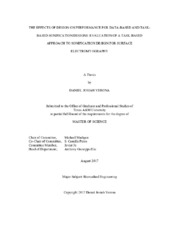| dc.description.abstract | The goal of this work was to evaluate a task-analysis-based approach to sonification design for surface electromyography (sEMG) data. A sonification is a type of auditory display that uses sound to convey information about data to a listener. Sonifications work by mapping changes in a parameter of sound (e.g., pitch) to changes in data values and they have been shown to be useful in biofeedback and movement analysis applications. However, research that investigates and evaluates sonifications has been difficult due to the highly interdisciplinary nature of the field. Progress has been made but to date, many sonification designs have not been empirically evaluated and have been described as annoying, confusing, or fatiguing. Sonification design decisions have also often been based on characteristics of the data being sonified, and not on the listener’s data analysis task.
The hypothesis for this thesis was that focusing on the listener’s task when designing sonifications could result in sonifications that were more readily understood and less annoying to listen to. Task analysis methods have been developed in fields like Human Factors and Human Computer Interaction, and their purpose is to break tasks down into their most basic elements so that products and software can be developed to meet user needs. Applying this approach to sonification design, a type of task analysis focused on Goals, Operators, Methods, and Selection rules (GOMS) was used to analyze two sEMG data evaluation tasks, identify design criteria that a sonification would need to meet in order to allow a listener to perform these two tasks, and two sonification designs were created to facilitate accomplishment of these tasks. These two Task-based sonification designs were then empirically compared to two Data-based sonification designs. The Task-based designs resulted in better listener performance for both sEMG data evaluation tasks, demonstrating the effectiveness of the Task-based approach and suggesting that sonification designers may benefit from adopting a task-based approach to sonification design. | en |


